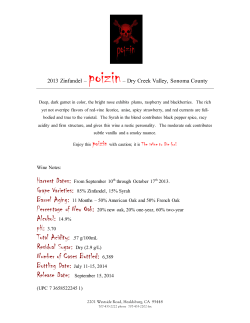
6.2 Oak Creek Reservoir
Initially Prepared 2016 Brazos G Regional Water Plan | Volume 2 Conjunctive Use | Oak Creek Reservoir 6.2 Oak Creek Reservoir 6.2.1 Description of Option The City of Sweetwater (Sweetwater) utilizes water supplies from the Oak Creek Reservoir in Coke County and the Champion Well Field in Nolan County. The wells are in the Dockum Aquifer. Prior to the drought beginning in 1998, the primary water supply was Oak Creek Reservoir and supplemental supplies from Lake Sweetwater, Lake Trammel and about eight wells in the Champion Well Field. Because of the 1998-2007 drought, the water supplies from the lakes diminished and finally disappeared. As a result, the City installed about 35 new wells in the Champion Well Field on an emergency basis. During the later part of the drought, groundwater from the Champion Well Field was the sole source of supply. Six more wells were added in the Summer of 2014, bringing the current well capacity for Sweetwater to a total of 4,142 acft/yr. To assess the long-term groundwater supplies from the Champion Well Field and in the general vicinity, a study was conducted for the Brazos G Regional Water Planning Group by HDR Engineering, Inc. (HDR). This study was partly funded by Sweetwater and consisted of: (1) developing a local groundwater model for western Nolan and eastern Mitchell Counties, (2) evaluating four potential groundwater pumping scenarios in the vicinity of the Champion Well Field with the groundwater model, and (3) evaluating the performance of wells in the Champion Well Field. Studies of Oak Creek Reservoir by Water Planning Groups in Region F and K have concluded that there is no firm yield for Sweetwater when considering existing senior downstream surface water rights. These studies have noted the feasibility of subordinating downsteam rights from Oak Creek Reservoir in the Colorado River Basin to increase local supplies. The conjunctive management concept for Sweetwater is to use Oak Creek Reservoir and Champion Well Field as parallel supplies. Both the reservoir and the well field will contribute on an average month, but either may be overdrafted when the other supply is low. The long term average of groundwater use must remain within the MAG even though it may be surpassed in any given year. This strategy will not involve any new facilities but will be composed of an operational strategy to balance supplies. The locations of Champion Well Field, Oak Creek Reservoir and Sweetwater are shown in Figure 6.2.1-1. May 2015 | 6.2-1 Initially Prepared 2016 Brazos G Regional Water Plan | Volume 2 Conjunctive Use | Oak Creek Reservoir Figure 6.2.1-1. Existing Champion Well field and Oak Creek Reservoir Locations 6.2.2 Available Yield The Champion Well field has a capacity of 4,142 acft/yr after the 2014 expansion. However, the availability to Sweetwater has been limited by MAG restrictions to 2,535 acft/yr. An analysis of Sweetwater’s demands and water supply contracts shows the peak demand during the planning period is 4,116 acft/yr in 2070. While Champion well field has sufficient capacity to meet annual demands, it is limited by available groundwater. The city also utilizes water supplies from the Oak Creek Reservoir and can purchase yield through subordination agreements, however, they cannot rely on this supply during times of drought. At least three Water Availability Model (WAM) simulations have been made for the Oak Creek basin by consultants for Region F. They are known as the Basin WAM, Run 3, and Mini-WAM. The first two simulations have a daily time step and end in 1998, thus they miss recent periods of drought. The Mini-WAM has monthly time intervals and ends in 2014. A result comparison of the Mini-WAM for Oak Creek Reservoir with historical results showed a reasonable match. For these reasons, the data from the Mini-WAM were used in this conjunctive use analysis. 6.2-2 | May 2015 Initially Prepared 2016 Brazos G Regional Water Plan | Volume 2 Conjunctive Use | Oak Creek Reservoir A study was conducted to balance the use of groundwater and surface water to limit depletion of available groundwater. Three strategies were used to meet the maximum need of 4,116 acft per year during the planning period without exceeding the long term MAG of 2,535 acft/yr and assuming subordination of downstream rights to Oak Creek Reservoir. The water level in Oak Creek Reservoir was used to determine the proportion of supply coming from each source. Strategy 1 relied on Oak Creek Reservoir as a primary source and utilized Champion Well Field only when needed to supplement supply. This involved the utilization of ground water when the reservoir dropped to 25% capacity. Figure 6.2.2-1 shows the temporal distribution of annual diversions and annual pumpage to meet 2070 demands. This figure shows that, the worst drought condition for this conjunctive water management strategy since 1940 would have been for 2010-2014 conditions. While Strategy 1 is a plausible operation scenario for the conjunctive use of Oak Creek and Champion well field, the aggressive utilization of surface water prevents Oak Creek from full recovery after periods of drought. Figure 6.2.2-2 shows the storage trace for Oak Creek assuming Strategy 1 was utilized under 2070 demands and 1940-2014 hydrologic conditions. The long term groundwater average use for Strategy 1 is 1,201 acft/yr, which is significantly less than the available supply for Sweetwater despite over drafting the MAG 18 of the 74 years. Figure 6.2.2-1. Strategy 1 Distribution of Water Sources for Sweetwater for 2070 Demands with 1940-2014 Hydrologic Conditions 4,500 Combined Yield = 4,116 acft/yr (3.7 MGD) 4,000 3,500 Total Supply (acft) 3,000 2,500 2,000 1,500 1,000 Groundwater 500 Surface Water 0 1940 1950 1960 1970 1980 1990 2000 2010 May 2015 | 6.2-3 Initially Prepared 2016 Brazos G Regional Water Plan | Volume 2 Conjunctive Use | Oak Creek Reservoir Figure 6.2.2-2. Strategy 1 Storage Trace for Oak Creek with 2070 Demands and 1940-2014 Hydrologic Conditions Strategy 2 attempts to maximize the use of Champion Well Field while keeping the long term groundwater use at or below the MAG limit. In this scenario, Oak Creek was used as the sole source of supply only when the reservoir was at 57% or above. Figure 6.2.2-3 shows the temporal distribution of annual diversions and annual pumpage to meet 2070 demands. The long term average groundwater use for this strategy is 2,531 acft/yr which is still less than the MAG of 2,535 acft/yr despite overdrafting 41 of the 74 years. The storage trace (Figure 6.2.2-4) for Oak Creek Reservoir under this strategy shows that the reservoir can recover when groundwater is used more frequently. 6.2-4 | May 2015 Initially Prepared 2016 Brazos G Regional Water Plan | Volume 2 Conjunctive Use | Oak Creek Reservoir Figure 6.2.2-3. Strategy 2 Distribution of Water Sources for Sweetwater for 2070 Demands with 1940-2014 Hydrologic Conditions 4,500 Combined Yield = 4,116 acft/yr (3.7 MGD) 4,000 3,500 Total Supply (acft) 3,000 2,500 2,000 1,500 1,000 Groundwater 500 Surface Water 0 1940 1950 1960 1970 1980 1990 2000 2010 Figure 6.2.2-4. Strategy 2 Storage Trace for Oak Creek with 2070 Demands and 1940-2014 Hydrologic Conditions May 2015 | 6.2-5 Initially Prepared 2016 Brazos G Regional Water Plan | Volume 2 Conjunctive Use | Oak Creek Reservoir The first two strategies show that while the needs can be met with either source set as a primary supply, relying too heavily on surface water can keep the reservoir from recovering and relying too heavily on groundwater will cause overdrafting of the MAG an undesirable number of years. A third strategy was considered that attempted to keep the long term averages of groundwater use and surface water use roughly equivalent. For this strategy, about 50% of the supply came from Oak Creek Reservoir and about 50% came from Groundwater for non-drought conditions. If in any given month, the reservoir dropped below 25% full, then groundwater was used as a sole source. Otherwise, the supply is a blend of the two sources. Figure 6.2.2-5 shows the temporal distribution of annual diversions and annual pumpage to meet 2070 demands. The long term average groundwater use for this strategy is 2,046 acft/yr which is still less than the MAG of 2,535 acft/yr and the MAG was only overdrafted 12 out of 74 years. The storage trace (Figure 6.2.2-6) for Oak Creek Reservoir under this strategy shows that while the reservoir does not fully recover, it remains at a higher level than in Strategy 1. Figure 6.2.2-5. Strategy 3 Distribution of Water Sources for Sweetwater for 2070 Demands with 1940-2014 Hydrologic Conditions 4,500 Combined Yield = 4,116 acft/yr (3.7 MGD) 4,000 3,500 Total Supply (acft) 3,000 2,500 2,000 1,500 1,000 500 Groundwater Surface Water 0 1940 6.2-6 | May 2015 1950 1960 1970 1980 1990 2000 2010 Initially Prepared 2016 Brazos G Regional Water Plan | Volume 2 Conjunctive Use | Oak Creek Reservoir Figure 6.2.2-6. Strategy 3 Storage Trace for Oak Creek with 2070 Demands and 1940-2014 Hydrologic Conditions 6.2.3 Environmental Issues There will be no new environmental impacts associated with this strategy. No wells, pipelines or other infrastructure will be built for this strategy. Implementation Issues Development of this water management strategy requires the subordination of the senior water rights that are downstream of Oak Creek Reservoir. May 2015 | 6.2-7 Initially Prepared 2016 Brazos G Regional Water Plan | Volume 2 Conjunctive Use | Oak Creek Reservoir This Page Intentionally Left Blank. 6.2-8 | May 2015
© Copyright 2025









